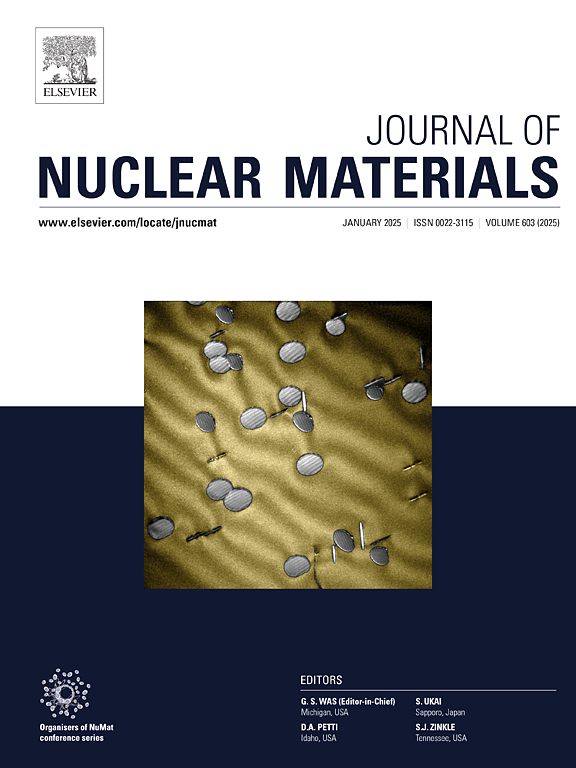反应堆压力容器脆化和硬化的机器学习分析综述
IF 2.8
2区 工程技术
Q3 MATERIALS SCIENCE, MULTIDISCIPLINARY
引用次数: 0
摘要
预测核反应堆压力容器的辐照脆化或硬化是保证核反应堆长期安全运行的关键。脆化趋势曲线(ETCs)作为化学和辐照环境变量的函数来预测RPV脆化。与传统的回归分析相反,人们对将机器学习(ML)应用于可用的机械测试数据以产生ETCs越来越感兴趣。这项工作对RPV脆化的ML应用现状进行了重点回顾,并确定了成功、失败和未来的机会。回顾表明,广泛的ML技术和方法已应用于RPV钢脆化数据的分析。ML模型能够比领先的分析ETCs更准确地预测辐照引起的脆化,然而,这只有在模型在包含足够训练数据的参数空间内进行插值时才是正确的。当外推-例如,到更高的影响- ML模型的准确性可能会大大降低,并且在某些情况下,无法做出物理上合理的预测。对RPV脆化贡献者的ML调查可以再现已知的主要影响,但尚未提供数十年协调研究中未知的见解,主要是由于缺乏考虑尚未已知的主导脆化的变量影响的研究。建议ML未来的工作有助于推进RPV脆化领域,并可能改进RPV结构完整性的预测,以支持长期操作目标。本文章由计算机程序翻译,如有差异,请以英文原文为准。
A Critical Review of Machine Learning Analyses of Reactor Pressure Vessel Embrittlement and Hardening
Predicting the irradiation-induced embrittlement or hardening of nuclear reactor pressure vessels (RPVs) is key for safe long-term operation. Embrittlement trend curves (ETCs) are used to predict RPV embrittlement as a function of chemical and irradiation environment variables. There is increasing interest in applying machine learning (ML) to available mechanical testing data to produce ETCs, as opposed to conventional regression analysis. This work provides a focused review of the current state of ML applications to RPV embrittlement and identifies successes, failures and opportunities for the future.
The review shows that a wide range of ML techniques and approaches have been applied to the analysis of RPV steel embrittlement data. ML models are capable of predicting irradiation-induced embrittlement even more accurately than the leading analytical ETCs, however, this is only true when the models are interpolating within parameter spaces containing sufficient training data. When extrapolating – e.g., to a higher fluence – ML model accuracy can drastically diminish and, in some cases, fail to make physically reasonable predictions. ML investigations of the contributors to RPV embrittlement can reproduce the dominant known effects but are yet to provide insights not known from decades of coordinated research, mainly due to a lack of studies considering the effects of variables not already known to dominate embrittlement. Future work is recommended for ML to help advance the field of RPV embrittlement and perhaps improve predictions of RPV structural integrity to support long-term operation goals.
求助全文
通过发布文献求助,成功后即可免费获取论文全文。
去求助
来源期刊

Journal of Nuclear Materials
工程技术-材料科学:综合
CiteScore
5.70
自引率
25.80%
发文量
601
审稿时长
63 days
期刊介绍:
The Journal of Nuclear Materials publishes high quality papers in materials research for nuclear applications, primarily fission reactors, fusion reactors, and similar environments including radiation areas of charged particle accelerators. Both original research and critical review papers covering experimental, theoretical, and computational aspects of either fundamental or applied nature are welcome.
The breadth of the field is such that a wide range of processes and properties in the field of materials science and engineering is of interest to the readership, spanning atom-scale processes, microstructures, thermodynamics, mechanical properties, physical properties, and corrosion, for example.
Topics covered by JNM
Fission reactor materials, including fuels, cladding, core structures, pressure vessels, coolant interactions with materials, moderator and control components, fission product behavior.
Materials aspects of the entire fuel cycle.
Materials aspects of the actinides and their compounds.
Performance of nuclear waste materials; materials aspects of the immobilization of wastes.
Fusion reactor materials, including first walls, blankets, insulators and magnets.
Neutron and charged particle radiation effects in materials, including defects, transmutations, microstructures, phase changes and macroscopic properties.
Interaction of plasmas, ion beams, electron beams and electromagnetic radiation with materials relevant to nuclear systems.
 求助内容:
求助内容: 应助结果提醒方式:
应助结果提醒方式:


